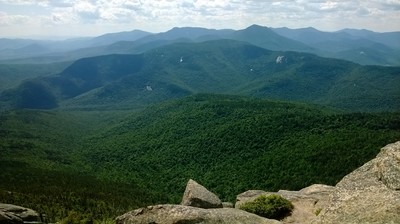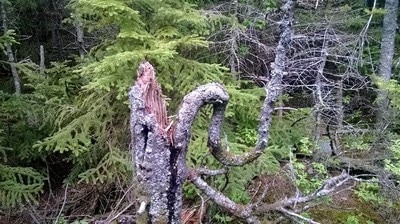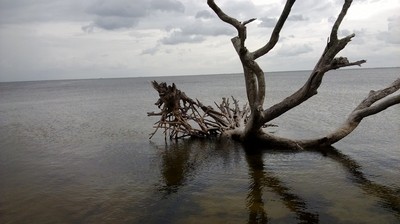|
This is an account of my trip through Vermont in 2011.
Molly Stark State Park – August 17 I drove to Molly Stark State Park and slept next to an apple tree. It smelled beautiful. I was careful to place my tent just out of range of the falling apples, but I had trouble driving the tent stakes through the pebble-filled soil. That night, I practiced roasting perfect marshmallows. Driving – August 18 I drove north to Lake Willoughby and drove around the area figuring out what trails there were to take. Later, I took route 105 east by numerous farms, trees, and mountains. It was a very scenic drive. There are entire sections of road that are nothing but pine and ferns. Finally, I found the dirt road off of 102 that leads to Maidstone State Park. After passing by nothing but trees for three miles or more, I suddenly found a row of houses around the edge of a lake. At the very end of the road is the park. Highlights: I saw a fox cross 105 in front of me. Mount Hor – August 19 Off of route 5A is a dirt road that goes nearly halfway up Mount Hor. I took the trail the rest of the way up. It was steep. I got very sweaty. Although the top is covered with vegetation, there are three cliff lookouts near the top with some limited visibility. Each is only big enough for two or three people. On my way from the second to the third lookout, I heard thunder. Soon after, I heard an approaching roar which turned out to be sheets of rain hitting the treetops. Seconds later, the storm was right over me. Less than two minutes later, the storm passed on. I continued to hear distant thunder as I reached the third lookout. Then I descended. Highlights: I saw a snake and more tiny toads than I could ever count. Mount Psigah – August 19 Directly across the road from the Mount Hor access road is the trail to climb Mount Psigah. Psigah and Hor flank the southern end of Lake Willoughby, with Psigah on the east. On the west (lake side) of Mount Psigah is mostly bare vertical rock, but from the south is a trail that leads to the top. It is very steep and I was exhausted by the time I reached an exposed area near the top. I also checked out two of the western lookouts. These are openings in the woods right at the edge of the cliff that offer a much better view than at Mount Hor, though they are just as small. They were awesome. Rather than keep looking for the others, I headed back down to eat and rest. At the very beginning of the trail is a pond with dead trunks sticking out of it. The way the sunlight caught them struck me as very nice. Unfortunately, I would not have my first camera until 2013. There is a lot of coniferous life on Mount Psigah, and it smells beautiful. There was also a lot of fungous, of many colorful varieties. In several places I swear I could smell rich, butter-fried, portabella mushrooms, but could not see them. It was very strong. Near the top there were birds whose wings made loud whirring noises when they took off. There was also a giant dragonfly whose wings were louder than I was used to. Highlights: I saw a large nest in a short tree near the top. I saw a dead insect I think must have been either a female dobsonfly or a horntail fly. Maidstone State Park – August 19 I drove back to Maidstone State Park by way of 105. As the sun set behind me, a strange mist began to rise from the forest around me. By the time I got to 102, I didn’t see it anymore. Arriving just after sunset, I sat by the lake and ate ravioli. That’s when I saw a loon surface just thirty feet from me. A few seconds later it was gone. I waited a long time for it to surface, but it never did – at least not where I could see it. That is the only time I have ever seen a loon. The park was surprisingly low on insects and I slept outdoors in one of their lean-tos. After climbing two mountains, sleep came easy. The next morning, I visited the beach there to take a quick swim. As I sat drying my feet on the rocks, I saw a large frog in the water. We stared at each other for minutes. Finally, I poked a stick toward him. He jumped up and bit the end of it! We played this game three more times. I’m not sure what his motives were. Later, I took the trail that ran along the shore from one beach to the second beach. Highlights: I saw many minnows and what must have been an ichneumon fly – something I have read about but never seen. Fairbanks Museum – August 20 I visited the Fairbanks Museum in Saint Johnsbury. Finding the street it was on was no problem, but finding which direction to go once on that street was. The museum itself has no sign, the front of it is obscured by trees, the angle of it one sees from the road is different than the angle in the brochure, and many of the buildings around there have the same style. Finally, I got inside. All the exhibits are in one large room and most of them are taxidermy. They were having a special on birds that week and so I saw hundreds of birds grouped by continent. There was also a moose, bears, monkeys, a tiger, a wolverine, a muskrat, and several other mammals. There was also a special section just for hummingbirds. There must have been a hundred hummingbird species represented. Really cool was the globe tool, a six-foot spherical screen that would show different rotating maps of Earth. Different choices included tectonic plates, ocean floor, and Earth after rising sea levels. There were also maps of The Moon, Mars, and other planets. The layout at the museum was sometimes irksome. One exhibit purportedly explained how and why early ideas of what dinosaurs were like differed from those today, but instead of showing a side by side comparison for each one, the arrangement of the models was scattered and incomplete. Often, it was difficult to tell where one exhibit ended and another began. I also noticed the usual “green” propaganda. A placard stated that species are disappearing today at a rate even faster than they did during the end of the age of dinosaurs, and that today’s rate of extinction is unprecedented. There is no way they could know this. The data is far too incomplete. The fossil record is so sparse that they can’t even find the “missing links”, how could they know for sure exactly when a species went extinct? Does anyone remember the coelacanth, the fish that everyone thought went extinct millions of years ago only to be found still living? Nobody is in agreement how many species are on the Earth in the first place, let alone how many are dying. We are still counting new ones and estimates of the total vary widely. Also, breeds and subspecies are reclassified as full, independent species all the time. I also happen to know that we simply lack the infrastructure to track population levels of every species there is, especially when some were only just discovered and may not ever be seen again. The world is a big place, and collection is based somewhat on luck. Incidentally, the extinction of the dinosaurs was not the greatest in history (the Permian-Triassic event was much greater), so it is a cherry-picked comparison in any case. Museums must hate me.
0 Comments
Leave a Reply. |
AuthorMy name is Dan. I am an author, artist, explorer, and contemplator of subjects large and small. Archives
February 2023
Categories
All
|



 RSS Feed
RSS Feed